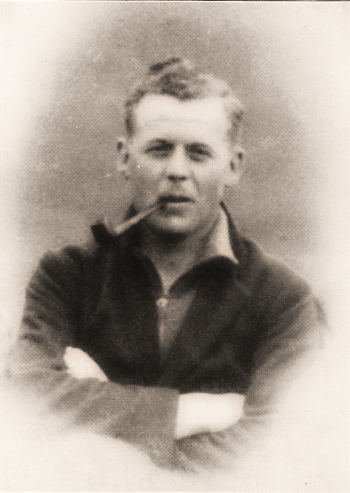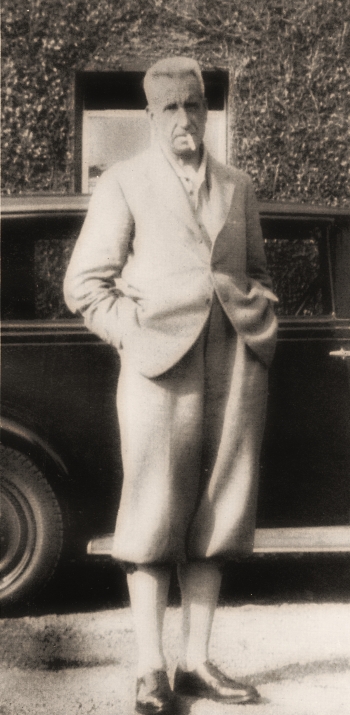In Memoriam
James Crowe
James Crowe died on October 10th, 1936, aged 32 years. He was born in Edinburgh and took an honours degree in chemistry at Edinburgh University, whence he joined the staff of Imperial Chemical Industries, and was stationed first at Winnington, and afterwards at Billingham.
Pot-holing and climbing won his enthusiasm from 1930 onwards and he was elected a member of the club in 1932. Climbing holidays took him to North Wales, the Lakes, Skye and in 1934 to the Lepontine Alps. At Gaping Gill in 1932 he was one of the party who arrived at the meet by way of Flood Entrance, and was at the bottom of the Main Shaft to greet the first man down.
Before 1936 his sight began to give him anxiety, and in March of that year he underwent an operation. This was partially successful, but he did not wholly recover from it. His courage and cheerfulness never failed, however, and it was a great shock when he died following a further operation. It was characteristic of him that, though he must have known the dangers attending the second operation he continued at work until he could hand over without inconvenience to his colleagues, and then went away quietly, with hardly a word of his trouble, so that his friends might not be distressed.
Jimmy, as he was always known, had a great generosity of spirit, and a charm which won him friends wherever he went, and never an enemy. His cheerfulness was immense and infectious, and all that he did was done with enthusiasm. Everyone who knew the joy of his companionship can tell of incidents—an overturned car, a fall while rock chmbing—not humorous in themselves, but which Jimmy by the spark of his personality turned into memories rich in laughter.
Jimmy never took any thought for the morrow ; he might possibly have lived longer if he had, but he would have lived less gaily and done less to make life good for those who knew him. It seems a hard thing that he who enjoyed this life so well and who hurt no one in his enjoyment of it, should have had to leave it so soon.
William Villiers Brown
The sudden death of William Villiers Brown, 25th October, 1936, at the age of 57, came as a great shock to his many friends ; his well-known figure will be greatly missed at all Y.R.C. Meets.
He was educated at Allan Glen’s School, Glasgow, but had been long in business in Leeds (he joined the Club in 1910) and was a director of J. Halden & Co., Ltd.
Brown was a great walker, and never happier than when tramping the dales and moorlands of Yorkshire. From Leeds to Simon’s Seat and back was many times a Sunday walk. On one occasion he walked from Fort William to Tyndrum, and another day-long walk, from Leeds, has become legendary.
He was an enthusiastic pot-holer, one of the first to lay siege to Diccan Pot, to the attack of which he returned many times, an article by him on the pot appearing in Vol. V. Ready and able to infect the beginner with his own enthusiasm and at the same time teach him to observe every safeguard, he was in his element when the work was heaviest, and we can recall some great feats of strength. One of the few active survivors of pre-war pot-holing, he was always to be counted on for support for any expedition and his loss was much felt when his knee hampered him in the last two or three years ; alas, that his constant interest and keenness are passed from us for ever.
Of his new explorations we recall Gingling Hole, Marble Steps, Gavel Pot, Rumbling Hole, Lost Johns’, Cradle Hole (Enniskillen), and many smaller ones.
Brown was, however, first of all a fine mountaineer, and the great hills were his delight. A splendid rock-climber, he was with the late C. D. Frankland on some of his first ascents in Lakeland, and climbed extensively in the British Isles. He had climbed without guides many peaks between Mont Blanc and the Bregaglia, was a member of the Alpine Club, and had been to Norway twice, to Corsica and to the Atlas Mountains (Y.R.CJ. V., “A Raid on the High Atlas”). A good companion of a generous nature, he was a man to depend on; his word was his bond.
Brown served several years on the Committee, was Vice-President, and was elected President, 1932-4, an honour he greatly appreciated, for he was heart and soul with the Club in all its doings.
William Martin Conway (1856-1937).
Baron Conway of Allington was long known as Sir Martin Conway, the writer of those classical books of mountaineering travel, Karakoram Himalayas, First Crossing of Spitsbergen, Bolivian Andes, and Alps from End to End.
He was one of the first Honorary Members of the Club, but as we can hardly claim that he was specially interested in or had a special connection with us, it is best to refer our readers to the full memoir in the Alpine Journal, and for Conway’s own account of his career to Mountain Memories.
One can remind younger men that all climbing guides spring from the Zermatt Pocket Book, and that Conway wrote the first Himalayan climbing book. Although he avowed a preference not to lead on the mountains, there is plenty of evidence that he was an expert with map and compass, and a real leader.
The barony no doubt came for national or political services, but during an evening the writer once spent with him Conway was emphatic that his knighthood was for mountaineering, not for art or politics, and very proud of it he was.
The Club was represented at the Memorial Service, St. Margaret’s, Westminster, 23rd April, 1937, by J. D. Ellis.
James Falshaw Watson
James Falshaw Watson died at Codsall Wood, Staffs, in June, 1937, aged 75. He had been a member since 1904, but since 1917 had been established at Bilston in the Black Country and had lost touch with our activities. An engineer by profession, he was a man of high repute in business. He had been a keen Rugby football enthusiast and was a great lover of the country.
William Anderton Brigg (1862-1938)
Yorkshire has lost much by the passing of William Anderton Brigg, on 4th January, 1938. Public representative, magistrate, philanthropist, and sportsman, he had built up a reputation which will not be forgotten.
Born August, 1862, a twin son of the late Sir John Brigg, M.P., he went to the Keighley Trade and Grammar School and to Giggleswick School, then to Trinity College, Cambridge, where he took his M.A. and LL.M. Called to the Bar in 1888, ten years later he settled down in Keighley as a solicitor. He was Clerk to the Denholme U.D.C., Registrar of the Keighley County Court, at one time acting Town Clerk, and an Assistant Charity Commissioner, holding enquiries into the ancient endowments of Kildwick, Halifax, Huddersfield and Sheffield.
Brigg became a Town Councillor in 1912 and the same year Mayor of Keighley, retaining the office four years. In the difficult days of the critical years he worked unstintingly to promote the interests of the local men on active service and in expanding the hospital service. Later he was Chairman of the War Pensions Committee, and his activity in this sphere was mentioned when the M.B.E. was conferred on him recently. He was chairman of many other bodies, and as an active educationist became Chairman of the West Riding Association of Part III. Education Committees.
He became Alderman in 1924, and next year was honoured with the Freedom of Keighley. Twice he fought unsuccessfully for a seat in Parliament.
Outstanding among the many benefactions in which he had a part was the magnificent gift to the National Trust by himself and his brother, County Alderman J. J. Brigg, of East Riddlesden Hall.
William Briggs’ chief recreation was mountaineering. From 1891 to 1914 he was every summer in the Alps or Norway, and became a member of the Alpine Club in 1894 (Committee 1911). He came into rock-climbing in the early days, and was in the first groups to practise on the gritstone outcrops as well as in the Lake District. With Solly, Slingsby and-Baker he was on the first climb of the Eagle’s Nest Ridge, and was with O. G. Jones on the first descent of Collier’s Climb.
In the Alps he was mostly with his brother, J. J. Brigg. and Eric Greenwood, climbing the Dom, Weisshorn, Schreckhorn, Matterhorn, etc. in 1891-4. Later they were particularly fond of long journeys and many passes. We mention the following :—
1895. Rossbodenjoch, Mischabeljoch, Colle delle Loccie, Lysjoch, Monte Rosa by the rocks, Col d’ Herens.
1897. Orsieres to Zermatt by the High Level Route, Breuil, Courmayeur, Mont Blanc traverse.
1899. Alpine Journal XXI, ” Through the Tarentaise and Beyond.”
1900. Gross Venediger to the Dolomites.
1902. Vélan, Grand Combin, Hohsand Pass, Tosa, Macugnaga, Weisstor.
1903. Alpine Journal XXII. “A Pilgrimage to Monte Viso.” One of the earliest climbs of the Viso N. E. ridge, 9 hours on the rocks.
1908. Zinal Rothorn, Rimpfischhorn, Col du Grand Cornier, Col des Bouquetins, Cogne, Herbetet, Degioz, Col du Geant.
1909. A. J. XXV, ” Mont Pourri, A Note.”
1913. Tirol—Vent, Similaun, Meran, Sterzing, Pfitschtal.
1914. Maritimes—Certosa di Pesio, Colpiano, Cima di Gelas, Ciriegia, Termi di Valdieri, Argentera. See A .J. XXIX, p. 300.
W.A.B. had ski-ed in the Black Forest (Y.R.C.J. Ill, p. 154) and at St. Moritz, and climbed several times in Scotland, Ben Nevis in snow, Glencoe and elsewhere. An article of his appears in S.M.C.J. XII, ” As Heaven’s Water Dealeth.”
The Yorkshire Ramblers’ Club he joined in the far-off days of 1894, became Editor of the Journal, 1909-20, and was elected President 1919-22. Being much interested in archasology he edited also two volumes of the Kildwick Parish Register.
Brigg’s life found natural expression in countless avenues of service. Never seeking any honour, never refusing any which came to him, he moved amongst us seeking ways in which he could assist his fellow men.


